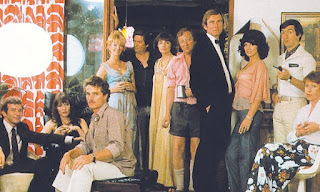Sharr White’s Annapurna (2011), directed in its regional premiere by Lynn Meyers, starts off as if it’s the sequel to one of Sam Shepard’s classics. Those crazy, intense lovers in their surreal spaces end up twenty years later in a trailer park. However, as the play progressed, it became apparent that it was the last embers of a romantic tragedy. As I said about Ensemble’s earlier production of White’s The Other Place last season, I don’t want to give too much away about the story behind the plot because it becomes far more intriguing than it initially appears.
 |
| Parlato and Pugh* |
Dennis Parlato gives a masterful performance as Ulysses, immediately establishing a complex, all-encompassing rhythm. He’s playing a semi-legendary character (sort of what Denis Johnson might have been like if he hadn’t kicked drugs and alcohol) faced with a major figure from his past. Unlike his namesake, he’s not going anywhere; he’s running out of time and is trapped in space. It took me a while to warm up to Regina Pugh as Emma, even though I have always admired her work. Susan and I thought she seemed as if she was in a light comedy at the beginning, while Katy and Lisa thought she was finding a way for her character to cope with the initial situation. Pugh always makes definite choices in her acting, which I respect, but they didn’t all work for me here. However, after the first half hour, she began to match Parlato beat for beat, resulting in a powerful climax.
| The Horrifying Set |
When we sat down as a group, Neil said, “Eric will have a tough time with this set.” It’s the type of design that gets a Tony nomination and three cheers to Brian c. Mehring for it and for the lighting and to Shannon Rae Lutz for the properties. It’s a life-size singlewide trailer that was built in the late ‘70s (my Mom has the same kitchen cabinetry) and has been inhabited by someone who’s somewhere between a nuclear slob and a toxic hoarder. I kept looking for the mummified pet that shows up on Hoarders, but fortunately Ms. Lutz didn’t go that far. I tried to avert my eyes from looking at it full on because it was like driving by a head on collision.
There are some clarifications needed from the script. Annapurna is a collection of mountains in the Himalayas and becomes significant because of Ulysses’ writing. Katy pointed out some inconsistencies in the exposition details. This is an established script so it cannot be changed, but I wonder why the original director or a dramaturge didn’t point this out to White. Also, did Emma buy groceries in Missouri because there isn’t a Piggly Wiggly in Colorado – the setting of the play? Is this in the script or a choice by Lutz?
*Photo from Ensemble Theatre website.
Annapurna runs through April 10, 2016.











